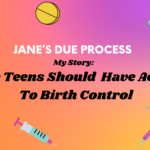This piece originally appeared on Generation Progress and can be found here.
Editor’s note: Names have been changed to protect the identities of the sources used in this article.
Jessica was 16 years old when she discovered she was pregnant and decided she wanted an abortion. Knowing that she needed to schedule an appointment immediately, she called the pregnancy resource center she passed every morning on her way to school.
At her first appointment, she immediately expressed her pregnancy decision to the staff. To her surprise, they did not offer her resources or instructions but instead badgered her with intense religious counseling and protestation. Jessica was bothered and skeptical, but she brushed away her discomfort and proceeded at the clinic; indeed, the white coats were compelling.
Persistent in her decision, the staff at the crisis pregnancy center (CPC) finally stopped trying to convince Jessica to continue with her pregnancy. They agreed to help her get an abortion but told her they were busy and couldn’t schedule her next appointment for a few weeks. While not ideal, this was acceptable, she thought, since they told her she was only about 10 weeks pregnant.
Over the next week, Jessica’s discomfort and suspicion grew. Her morning sickness was unbearable and she was experiencing excruciating pains in her abdomen. She continued her research and decided to make an appointment at an abortion clinic.
Jessica’s new doctor told her that she was not, in fact, 11 weeks pregnant, but rather 19—just one week away from the legal limit.
If she had waited for her appointment at the crisis pregnancy center, she would have missed the 20-week window for legal abortions, forcing her to continue with her pregnancy. This, of course, was no mistake.
Discouraged and confused, Jessica listened as the doctor explained to her that the crisis pregnancy center where she had been was a religious anti-abortion center.
With financial assistance from independent funding organizations, Jessica was able to terminate her pregnancy, but others are not so lucky.
Just a few months ago, a teen I worked with had a similar experience at a crisis pregnancy center. This time, the CPC “successfully” waited her out and she was unable to afford the out-of-state travel to terminate the pregnancy legally. She was 14 years old.
Another young woman who went to a crisis pregnancy center was subjected to “counseling” from an “abortion survivor” who warned her of lifelong emotional scars. And another young woman who was to start chemotherapy in the coming months was shown such graphic images and given such dramatic descriptions of her fetus that she eventually felt too guilty to have an abortion.
More, a teen whose mother had died a mere three months prior was asked by crisis pregnancy center staff if she would like to end up in heaven with her mother or in hell without her. “Don’t you want to see your mother?,” they asked.
Crisis pregnancy centers exist to dissuade women from terminating their pregnancies by employing callous tactics of shame and deceit. Although staff often dress in white coats, they are not always doctors, or even licensed medical physicians. And while they advertise abortion services, abortion care is not provided. CPCs will even stake out property near real abortion clinics and pretend that they are the real clinic to trick women into using their services.
And they intentionally prey on young women—particularly those who are the most scared, most trusting, and most desperate.
Often located on or near college campuses crisis pregnancy centers advertise free pregnancy services—specifically, sonograms—whereas state-certified abortion clinics must charge around $100 for the initial consultation (sonogram and pregnancy options counseling). This is their initial allure—and it does particularly well with young and low-income women. Armed with the knowledge that college students are often in need of sexual health services, and, at the same time, on tight budgets, crisis pregnancy centers can easily target this vulnerable population. Even worse, the sonogram conducted at the crisis pregnancy center Jessica attended does not meet the requirements Texas state law mandates for sonograms. In fact, no sonogram offered at any crisis pregnancy center in the state of Texas would meet the state’s requirements, since Texas law requires that the same doctor who performs the abortion also perform the sonogram.
Once women enter with the promise of free services, they are subjected to an arsenal of strategiesintended to scare, intimidate, and shame them for their choice. Such tactics range from grotesque images of ostensibly aborted fetuses, misinformation about the emotional and physical risks of abortion, religious propaganda, and outright moral berating. Devastatingly, patients are often givenincorrect medical information regarding their pregnancy.
Despite their very obvious lack of empathy for women facing unwanted pregnancies, CPCs exist in every state across the United States, and 11 states provide them with funding. Functioning under three main umbrella organizations—Heartbeat International, Care Net, and the National Institute of Family and Life Advocates—there are an estimated 3,500 CPCs nationwide, with three CPCs for every one abortion clinic.

Source: NARAL Pro-Choice Texas (www.txpregnancy.org)
Tax dollars fund the existence of crisis pregnancy centers under the guise that CPCs provide necessary services to pregnant women. But crisis pregnancy centers do not exist to assist women in continuing their pregnancies, rather they exist simply to deter women from terminating their pregnancies. Their calls of “Pregnant? Need Help?” ring silent in the ears of women seeking access to all of their pregnancy options, not simply those that are deemed acceptable by a certain ideology.
If crisis pregnancy centers only existed to help women who chose adoption or parenting, and simply offered factual, medical information about abortion, I would tout their work. But the reality is, they do not.
No matter one’s attitude concerning abortion, at minimum we must agree that women should receive genuine, fact-based medical care.It ought to be a basic assumption that state-funded institutions like crisis pregnancy centers prioritize health, not religious or ideological agendas.



